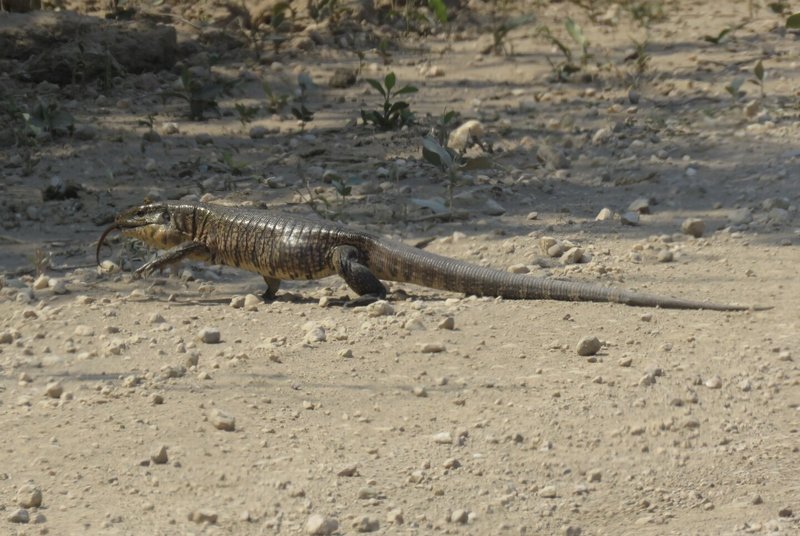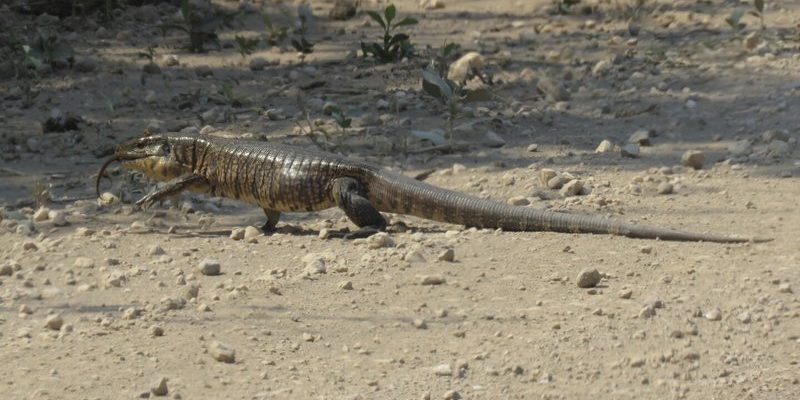
The Caiman Lizard, with its striking appearance and unique personality, is a fascinating reptile that captures the imagination of many animal lovers. Imagine a creature that looks like a mix between a small alligator and a colorful iguana. Its vibrant scales and powerful build make it truly stand out in the world of reptiles. You might be wondering where these remarkable lizards come from and how they behave. Let’s dive into the captivating life of the Caiman Lizard.
Originating from the waterways of South America, particularly the Amazon Basin, this lizard prefers habitats that mimic its natural environment. It navigates through wetlands and swamps, showcasing both its swimming skills and love for basking in the sun. Not only is it visually stunning, but it also plays a significant role in its ecosystem, feeding on snails and other invertebrates. Understanding the Caiman Lizard will give you a glimpse into a reptile that is both a fierce predator and a vibrant part of its environment.
Physical Characteristics
The Caiman Lizard can grow to impressive lengths, reaching up to about 3.5 feet. Its elongated body is complemented by a robust tail, which helps it swim gracefully through the water. This lizard’s skin is adorned with bright green to yellowish hues, interspersed with intricate patterns resembling armor. These colors aren’t just for show; they play a vital role in camouflage, helping the lizard blend into its lush, watery surroundings.
Another striking feature of the Caiman Lizard is its strong jaw filled with sharp teeth, perfect for cracking open the hard shells of snails. The jaw structure is crucial for its feeding habits, as snails are a primary part of its diet. Additionally, the lizard’s limbs are powerful, allowing it to climb and move efficiently both in water and on land. These adaptations give the Caiman Lizard an edge in its natural habitat.
Habitat and Distribution
You’ll primarily find the Caiman Lizard in the tropical rainforests of South America. It thrives in freshwater environments, such as swamps, marshes, and rivers, where it feels right at home. This lush habitat not only provides shelter but also an abundance of food sources. The climate is warm and humid, which is essential for its survival and activity.
It’s interesting to note that these lizards are semi-aquatic. They spend a lot of time in the water, where they can escape predators and hunt for food. Lima, Peru, and various parts of Brazil are notable locations where the Caiman Lizard thrives. However, habitat destruction poses a threat to their numbers, making conservation efforts vital for this unique species.
Diet and Feeding Habits
The Caiman Lizard’s diet mainly consists of snails, but it also enjoys consuming other invertebrates and occasional plant matter. This diet is not just a random choice; it’s specifically adapted to their strong jaws and teeth, which can crush the shells of their favorite snacks. When hunting, the Caiman Lizard uses its keen eyesight and stealthy movements to catch its prey by surprise.
Interestingly, their feeding habits vary based on their environment and available food sources. In times when snails are scarce, these lizards have been known to switch to other invertebrates. They can often be seen basking on rocks or logs, soaking up the sun before heading into the water to hunt. Their ability to adapt their diet is crucial for their survival in changing environments.
Behavior and Social Structure
You might be surprised to learn that Caiman Lizards aren’t just solitary creatures. While they often prefer to live alone, they can sometimes be spotted basking in groups. This behavior is believed to help them regulate their body temperature, especially since they thrive in warmer climates. When it comes to mating, the males are known to be quite territorial and will display aggressive behaviors to ward off rivals.
During the breeding season, the males become more vocal, using various sounds to attract females. After mating, the female lays eggs, usually in a nest close to water in order to keep them moist. This nurturing behavior ensures the young have access to their aquatic habitat right from the start. Social interactions among Caiman Lizards mainly revolve around mating and territory defense, which are essential for their reproduction and survival.
Conservation Status
The Caiman Lizard is currently listed as vulnerable due to habitat destruction and over-exploitation for the pet trade. As their natural habitats are threatened by deforestation and pollution, their populations have started to decline. This is concerning, not only for the species itself but also for the ecosystem it helps maintain.
Conservation efforts are underway in various regions to protect the Caiman Lizard and its habitat. Organizations are working to raise awareness about the importance of preserving wetlands and enforcing regulations on wildlife trade. By educating local communities about the ecological role of the Caiman Lizard, we can foster a deeper respect for this unique creature and its environment.
Care and Keeping as Pets
If you’re considering keeping a Caiman Lizard as a pet, there are several factors to keep in mind. First, these lizards require a large, suitable enclosure that mimics their natural habitat. An aquarium or terrarium with both land and water areas is essential for their comfort and well-being. You’ll also need to regulate the temperature and humidity levels, ensuring a warm environment for basking.
Feeding your Caiman Lizard a proper diet is crucial. You can provide them with snails, which can often be found at pet stores. It’s vital to avoid feeding them just plant-based foods, as they require a protein-rich diet to thrive. Additionally, make sure to provide clean water to ensure they stay hydrated and healthy.
Reproduction and Lifespan
The breeding season for Caiman Lizards typically occurs during the warmer months. After mating, the female lays clutches of eggs in nests close to the water. The incubation period lasts around 90 to 100 days, after which the young hatch. These hatchlings are relatively small but are already equipped with the instincts necessary to survive in the wild.
In terms of lifespan, Caiman Lizards can live up to 20 years in captivity if well cared for. This longevity makes them a long-term commitment for anyone considering keeping them as pets. Providing the right care is essential to ensure they lead a healthy and active life. Understanding their needs and behavior will make your experience much more rewarding.
Table of Interesting Facts
| Species Name: | Caiman Lizard |
| Scientific Name: | Dracaena paraguayensis |
| Length: | Up to 3.5 feet |
| Diet: | Snails, invertebrates, some plants |
| Habitat: | Tropical rainforests, freshwater environments |
| Lifespan: | Up to 20 years in captivity |
| Conservation Status: | Vulnerable |
FAQ
What is the best environment for a Caiman Lizard in captivity?
Creating an ideal environment for a Caiman Lizard involves a carefully designed tank that includes both land and water areas. Aim for a spacious terrarium that replicates their natural habitat. The water section should be deep enough for swimming, while the land area should have plenty of hiding spots and basking spots. Maintain warm temperatures and high humidity levels to mimic their tropical environment.
How do Caiman Lizards communicate?
Caiman Lizards have various ways of communicating, including vocalizations, body language, and scent marking. During the mating season, males often use vocal calls to attract females. They may also display aggressive behavior, such as head bobbing or puffing up their body to establish dominance over rivals. Understanding these signals can give insight into their social interactions.
Are Caiman Lizards suitable pets for beginners?
While Caiman Lizards are fascinating creatures, they may not be the best choice for beginners. Their specific care needs, such as habitat requirements, diet, and temperature control, can be challenging for those new to reptile keeping. It’s important to research thoroughly and ensure you can meet their needs before committing to one as a pet.
What do Caiman Lizards eat in the wild?
In their natural habitat, Caiman Lizards primarily feed on snails, which are abundant in their aquatic environments. They are also known to consume other invertebrates and occasional plant matter. Their strong jaws are specially adapted to crack open the hard shells of snails, making them efficient predators in their ecosystem.
How can I help in the conservation of Caiman Lizards?
You can help with conservation efforts by supporting organizations that focus on preserving Caiman Lizard habitats and managing sustainable practices in the pet trade. Educating others about the importance of this species and their ecosystem can also spread awareness. Participating in local clean-up efforts in wetlands can contribute to protecting their natural environments.
Can Caiman Lizards swim?
Yes, Caiman Lizards are excellent swimmers! Their bodies are streamlined for aquatic movement, and they often dive to escape predators or hunt for food. They have a strong swimming ability, which is one of the reasons they thrive in their natural habitats near water.
Do Caiman Lizards need UV lighting in captivity?
Yes, Caiman Lizards benefit from UV lighting in captivity. This lighting helps them synthesize vitamin D3, which is essential for calcium absorption and overall health. Providing an appropriate UV source in their habitat mimics the natural sunlight they would receive in the wild.
How do Caiman Lizards reproduce?
Caiman Lizards reproduce by laying eggs after a mating season that occurs during warmer months. The female typically lays her eggs in nests close to water. The incubation period lasts around 90 to 100 days before the eggs hatch, and the young are immediately adapted to their aquatic environment.
Are Caiman Lizards social animals?
While Caiman Lizards are generally solitary creatures, they can sometimes be seen basking in groups. Their social interactions are primarily related to mating and establishing territories. During the mating season, males can be more vocal and interactive as they seek to attract females.
What threats do Caiman Lizards face in the wild?
Caiman Lizards face several threats, including habitat destruction due to urbanization and agriculture, as well as over-exploitation for the pet trade. These factors have led to a decline in their populations, making conservation efforts crucial to ensure their survival.
What is a good diet for a captive Caiman Lizard?
A well-rounded diet for a Caiman Lizard in captivity includes a variety of snails, which are essential due to their dietary preferences. You can also provide other invertebrates and some greens to ensure a balanced intake of nutrients. Always ensure that the food is appropriate for their size and dietary needs.

